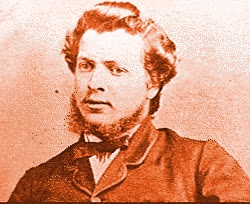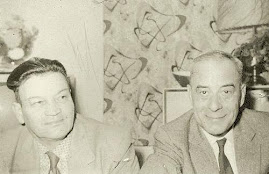Honouring our history - our roots and the proud heritage of our ancestors only strengthens us. I wish these people success in their most admirable cause.
Descendants of Metis warriors bring history to life
Published Saturday March 21st, 2009
WAKAW, Sask. - The Jobin brothers were "scattered like rats" across the Prairies after Batoche fell.
Published Saturday March 21st, 2009
WAKAW, Sask. - The Jobin brothers were "scattered like rats" across the Prairies after Batoche fell.

The Canadian Press
Battle of Batoche: Ron Jobin, a former farmer from Domremy who discovered a passion for his Metis roots at around age 40, is working together with his long-lost family members to buy a tombstone for their common ancestor, who died from wounds sustained at the Battle of Batoche.
Second-oldest brother Ambroise, 34, had his leg amputated soon after the battle in a makeshift hospital in Saskatoon.
Several weeks later, he died. His body was sent back to Batoche and laid to rest next to the mass grave where his Metis comrades-in-arms all ended up.
The other four brothers, one as young as 16 at the time of the Battle of Batoche, eventually turned up in northern Alberta, Manitoba and North Dakota. They and their five sisters had kids, who in turn had children, which led to yet another group of Jobin youngsters.
This generation of baby boomers was the one to bring the battle full circle. In June, through hard detective work back through the ages and some random good fortune, the Jobins got back together at Batoche for a family reunion.
One of their first orders of business was to erect a proper gravestone for their great-uncle. The North West Mounted Police likely gave him a wooden cross, but this would have rotted away.
And this brings us to today. Ron Jobin, a former farmer from Domremy, Sask., turned amateur family historian, and Beatrice Demetrius (nee Jobin), the Metis Nation of Alberta's genealogist and researcher, have been making slow progress in fundraising for their little family project.
They estimate that two simple headstones - the other one is for Joseph Ouellette, a 93-year-old Metis warrior killed on the last day of the battle and given his own casket and grave as a sign of respect for his age - would cost between $3,500 and $4,000. They've raised some money from Jobins across the country but still fall way short of their mark.
"When you look at the history books, it seems like only two men fought at this battle. And believe me, they're my heroes too. But I wanted these other men to be known," said Demetrius, who started fundraising for Ouellette two years ago.
The other four brothers, one as young as 16 at the time of the Battle of Batoche, eventually turned up in northern Alberta, Manitoba and North Dakota. They and their five sisters had kids, who in turn had children, which led to yet another group of Jobin youngsters.
This generation of baby boomers was the one to bring the battle full circle. In June, through hard detective work back through the ages and some random good fortune, the Jobins got back together at Batoche for a family reunion.
One of their first orders of business was to erect a proper gravestone for their great-uncle. The North West Mounted Police likely gave him a wooden cross, but this would have rotted away.
And this brings us to today. Ron Jobin, a former farmer from Domremy, Sask., turned amateur family historian, and Beatrice Demetrius (nee Jobin), the Metis Nation of Alberta's genealogist and researcher, have been making slow progress in fundraising for their little family project.
They estimate that two simple headstones - the other one is for Joseph Ouellette, a 93-year-old Metis warrior killed on the last day of the battle and given his own casket and grave as a sign of respect for his age - would cost between $3,500 and $4,000. They've raised some money from Jobins across the country but still fall way short of their mark.
"When you look at the history books, it seems like only two men fought at this battle. And believe me, they're my heroes too. But I wanted these other men to be known," said Demetrius, who started fundraising for Ouellette two years ago.
Demetrius and Jobin want to make sure the gravestones are in place by the 125th anniversary of the battle in May 2010.
Right now there's a group memorial for the Metis soldiers laid to rest in the mass grave and a memorial to the one Canadian soldier lying in the riverbank, but there's nothing for Ambroise or Ouellette except a simple wooden cross he put in a few years ago, Jobin said.
To hear him talk about the battle is to bring it out of the history books, to make it seem as close as it is to his heart. He described how Ambroise, who sat on Louis Riel's council, walked with a limp and was shot in his only good leg in the last round of fighting.
"If you were not Protestant, white and English-speaking, they burnt your buildings down and drove you out of the area. And I'm not knocking these people. That's the way it was back then," said Jobin.
"The last day the Metis were out of ammunition. They were shooting horseshoe nails and stones out of their muskets. It was pretty well the end."
"I know that Ambroise was wounded and one of his buddies helped him. He crawled and got help, crawled about 30 or 40 yards, into some willows. His buddy said to him, 'Stay here, they won't kill you because you speak English.'"
"I remember my dad saying that his great-uncles would say that (Ouellette) could have got away, but he wanted to get one more redcoat. Just didn't quit. Eventually the redcoats got him."
Why does it matter what happened to such a distant relative?
"It's my culture, it's my family, and I want them to find their rightful places in history. I want my Metis people to honour these men, to find out and be proud that that's their soldier, that's their ancestor, and that they should recognize these men," Demetrius said, adding that she's always encouraging distant relatives of soldiers who fought at Batoche and other battles to dig deep into their family histories.
For Jobin, it's about knowing where he comes from, something that he says people seem to suddenly take an interest in when they reach middle age.
"If it had been of interest to me in high school, my history mark would have been a heck of a lot better than it was," he joked.
But in a turn to the more serious, Jobin said that things have changed and that there are more people looking to rediscover their Metis roots. Older generations often didn't even self-identify as Metis and Jobin had a friend whose Metis dad claimed to be Hawaiian, he said.
Demetrius agrees, adding that nowadays she gets people coming into her office all the time with lists of family names or photos of family members who "look First Nations" to see if their ancestors were Metis.
"We have a lot of adoptees trying to find out about their culture, trying to find out where they belong," she said. "After 1885 there was a big suppression and it was not so cool to be known as a Metis or half-breed. So if you could be something else, then that's what you were."
"They just wanted to get out of here because they'd end up like Louis Riel, hanging from a rope somewheres," Jobin said.
To see what's changed, all one has to do is look at the bent given to historical education these days. No longer are schoolchildren taught that the Metis soldiers were rebels and criminals, as Jobin was taught when he was a student.
To hear him talk about the battle is to bring it out of the history books, to make it seem as close as it is to his heart. He described how Ambroise, who sat on Louis Riel's council, walked with a limp and was shot in his only good leg in the last round of fighting.
"If you were not Protestant, white and English-speaking, they burnt your buildings down and drove you out of the area. And I'm not knocking these people. That's the way it was back then," said Jobin.
"The last day the Metis were out of ammunition. They were shooting horseshoe nails and stones out of their muskets. It was pretty well the end."
"I know that Ambroise was wounded and one of his buddies helped him. He crawled and got help, crawled about 30 or 40 yards, into some willows. His buddy said to him, 'Stay here, they won't kill you because you speak English.'"
"I remember my dad saying that his great-uncles would say that (Ouellette) could have got away, but he wanted to get one more redcoat. Just didn't quit. Eventually the redcoats got him."
Why does it matter what happened to such a distant relative?
"It's my culture, it's my family, and I want them to find their rightful places in history. I want my Metis people to honour these men, to find out and be proud that that's their soldier, that's their ancestor, and that they should recognize these men," Demetrius said, adding that she's always encouraging distant relatives of soldiers who fought at Batoche and other battles to dig deep into their family histories.
For Jobin, it's about knowing where he comes from, something that he says people seem to suddenly take an interest in when they reach middle age.
"If it had been of interest to me in high school, my history mark would have been a heck of a lot better than it was," he joked.
But in a turn to the more serious, Jobin said that things have changed and that there are more people looking to rediscover their Metis roots. Older generations often didn't even self-identify as Metis and Jobin had a friend whose Metis dad claimed to be Hawaiian, he said.
Demetrius agrees, adding that nowadays she gets people coming into her office all the time with lists of family names or photos of family members who "look First Nations" to see if their ancestors were Metis.
"We have a lot of adoptees trying to find out about their culture, trying to find out where they belong," she said. "After 1885 there was a big suppression and it was not so cool to be known as a Metis or half-breed. So if you could be something else, then that's what you were."
"They just wanted to get out of here because they'd end up like Louis Riel, hanging from a rope somewheres," Jobin said.
To see what's changed, all one has to do is look at the bent given to historical education these days. No longer are schoolchildren taught that the Metis soldiers were rebels and criminals, as Jobin was taught when he was a student.
But Demetrius was always taught in her own family to be proud of their ancestors at Batoche, who fought not a rebellion but a "resistance," she said.





2 comments:
This is very interesting story, I bet theres lots more out there. Metis Mama this is why we, at Metisfest have a message board set up to help all us metis to find family we all know deep down is out there. If Ron Jobin or Beatrice Demetrius are reading this please check out www.metisfest.com and look under contacts for my name Dan Goodon and please get intouch with me. Let get this International Ball Rolling !
Thanx for the great story Metis Mama
To Beatrice Demetrius:
I think I may have found the death date and place of Joseph Jobin in North Dakota. You can contact me at andre.martel2008@gmail.com
Post a Comment